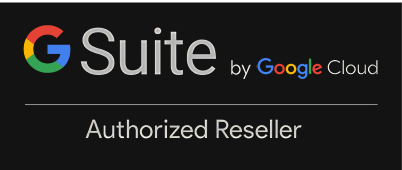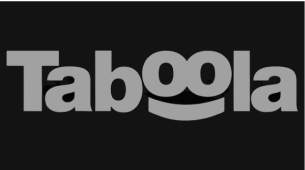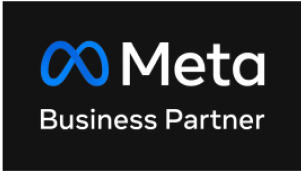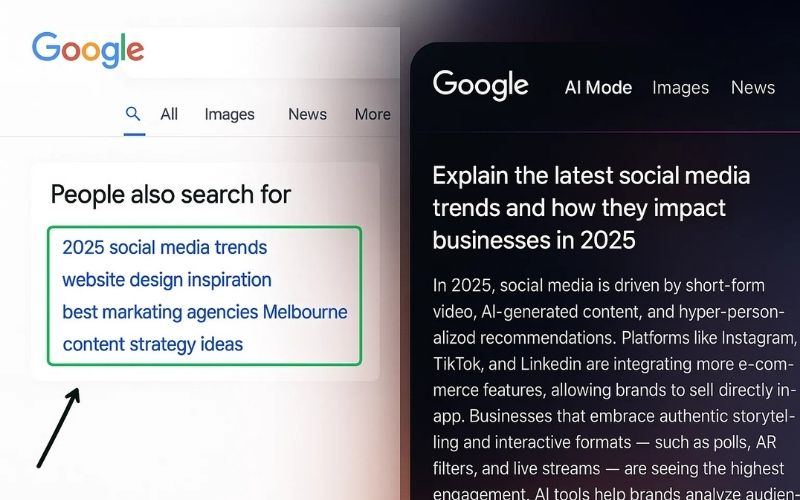
Once upon a search, People Also Search For was the quiet librarian, offering you a neat stack of “you might like this” queries before stepping back into the shadows. Handy, sure. But now? Google’s AI Mode has burst through the library doors, tossing out dusty index cards and replacing them with a dynamic, living conversation. The once-static suggestion box has levelled up into a real-time, context-aware sidekick that evolves with your curiosity.
And this shift isn’t just a tweak; it is a complete remix of the search experience. We are talking about a new rhythm in how queries are answered, connections uncovered, and next steps revealed. If you have ever wanted search to feel less like a chore and more like a discovery you can’t put down, this is where it happens. Let’s unpack how People Also Search For and AI Mode together are rewriting the rules of Search UX.
What’s Inside:
- A Look Back: The Role of People Also Search For in User Discovery
- AI Mode Unpacked: Key Features Driving the Next Search Revolution
- People Also Search For Meets AI Mode: What It Means for Search UX
- Strategies to Elevate Your Brand with AI Mode-Driven Search UX
- Level Up Your Search UX for the AI Mode Era
A Look Back: The Role of People Also Search For in User Discovery
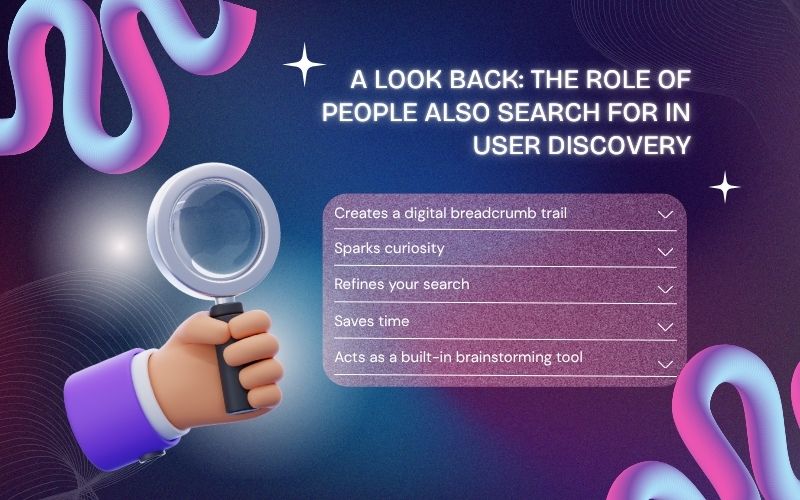
If you have ever clicked on a Google result, then bounced back to the search page, you have probably seen that little box titled People Also Search For. It is Google’s way of saying, “Hey, you might be looking for this too.” These suggestions are based on what other users searched for in similar situations, offering a quick list of related queries right under the result you just explored.
Over the years, this small feature has played a surprisingly big role in how we discover information online:
- Creates a digital breadcrumb trail- Pointing you toward related answers and deeper insights without having to start from scratch.
- Sparks curiosity- Introducing new angles or topics you might not have thought to search for yourself.
- Refines your search- Helping you narrow down results to match your true intent.
- Saves time- Keeping your search flow uninterrupted with instant, relevant suggestions.
- Acts as a built-in brainstorming tool- fuelling your next query just when you think you have exhausted your options.
In short, People Also Search For has quietly shaped the way we explore the web, turning simple searches into wider journeys of discovery.
AI Mode Unpacked: Key Features Driving the Next Search Revolution
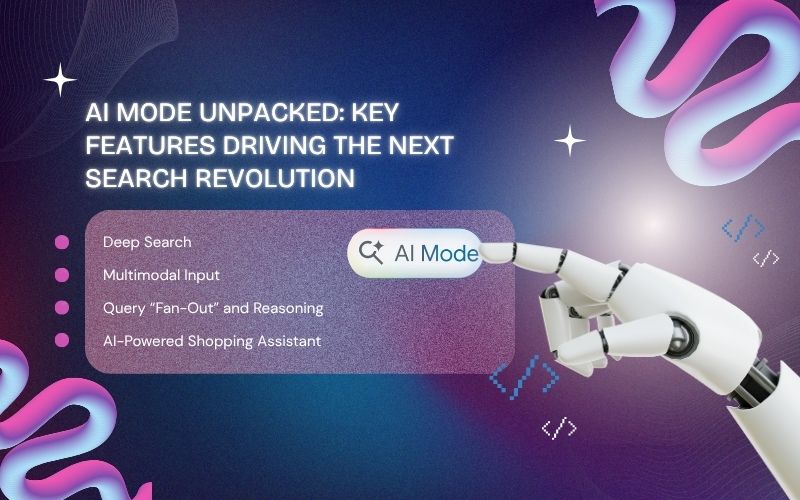
AI Mode is Google’s experiment to make Search feel a lot more like chatting with an intelligent assistant than scanning lists of links. Rolled out in early 2025 via Labs and fully expanded to U.S. users by May 2025, it is powered by the Gemini AI model, initially Gemini 2.0 and now upgraded to Gemini 2.5, bringing advanced reasoning and multimodal capabilities to your search bar.
Here are some of its key features driving the next search revolution:
Deep Search
AI Mode doesn’t just look for keywords; it actively decomposes your query into multiple subtopics, running hundreds of mini-searches in the background. This allows it to synthesise results into a highly detailed, coherent answer that feels like an expertly researched report.
For example, instead of scanning multiple links yourself, you could receive a fully-cited, multi-section answer in minutes, complete with source transparency and the exact time or date the information was pulled.
Multimodal Input
You can interact with AI Mode in the way that feels most natural, by typing, speaking, or even uploading images. It can interpret and respond intelligently to all of them.
For example, you might snap a photo of a plant and ask what it is; AI Mode will not only identify it but also provide care tips, related articles, and visual references. Image-uploaded searches are now clearly marked in your AI Mode history with an image favicon, making it easy to find them later.
Query “Fan-Out” and Reasoning
When you submit a complex question, AI Mode “fans out” the query into many smaller, more specific searches. It then applies reasoning to connect the dots between different pieces of information, building a well-rounded, context-aware answer.
AI-Powered Shopping Assistant
Shopping in AI Mode is more than just product listings; it is an interactive, personalised buying journey. You can upload an image of an outfit, accessory, or gadget you like, and AI Mode will match it with products in Google’s Shopping Graph. New enhancements include:
- 360° product images (generated by Google for better visualisation)
- Price tracking and best price alerts to help you buy at the right time
- People Also Ask (PAA) suggestions to refine your search
- Top insights from review sites, YouTube videos, and even Reddit discussions for authentic user feedback
- Seamless checkout integration via Google Pay
People Also Search For Meets AI Mode: What It Means for Search UX
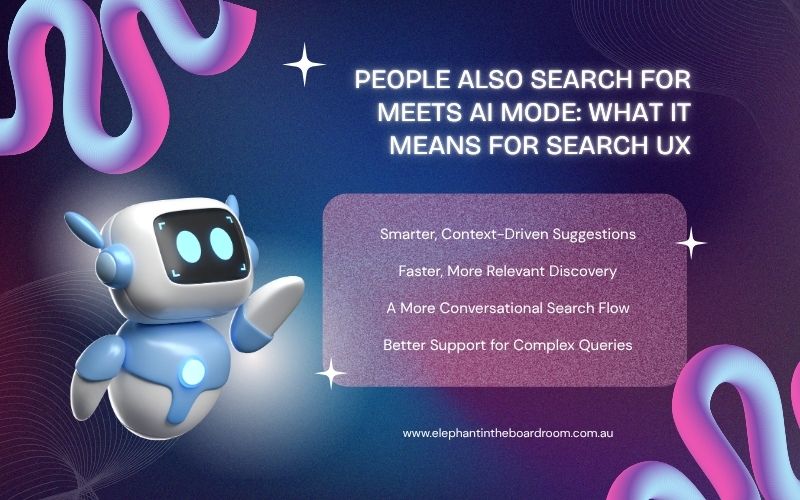
We are in the middle of a search revolution, where the experience matters just as much as the answer. Here’s what it means for search UX:
Smarter, Context-Driven Suggestions
Instead of showing you a static list of related searches, AI Mode can interpret the context of your query in real time. This means the suggestions adapt based on your intent, previous searches, and even follow-up questions. You’re getting results that feel personalised, not just pre-programmed.
Faster, More Relevant Discovery
With AI Mode, the “People Also Search For” section becomes less about random options and more about anticipating your next step. It can surface resources, comparisons, and deeper insights without you having to start a new search. This makes exploring topics quicker and more intuitive.
A More Conversational Search Flow
AI Mode allows you to refine or branch out from your search without jumping back to square one. Instead of just clicking a related term, you can engage with follow-up prompts that expand or narrow your results naturally. It feels more like a dialogue than a list of clickable links.
Better Support for Complex Queries
When your search involves multiple layers, like researching, comparing, and deciding, AI Mode enhances “People Also Search For” to handle that complexity. It can connect related ideas, suggest expert-level content, and guide you toward well-rounded answers. This helps you stay on track, even with tricky topics.
Tips to Elevate Your Brand with AI Mode-Driven Search UX
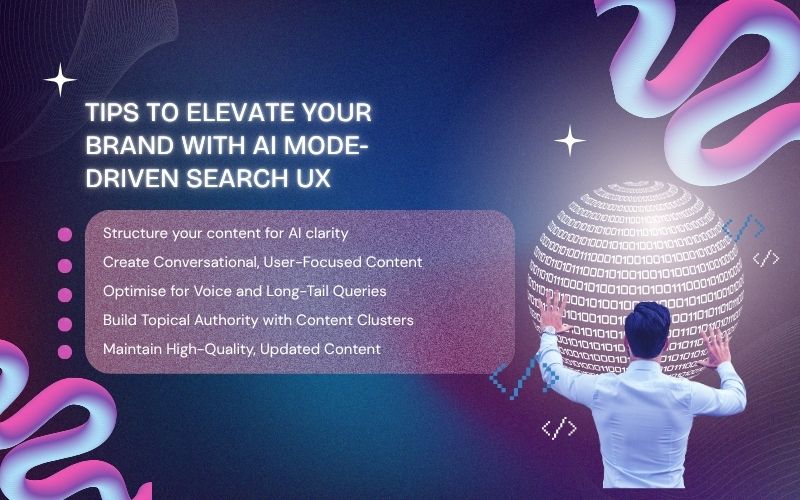
Standing out online has never been more challenging, or more exciting. Search results are getting smarter, faster, and more personal, which means the way you present your brand matters more than ever. Success now comes down to how clearly, confidently, and consistently you show up.
The following are the key strategies to elevate your brand:
Structure Your Content for AI Clarity
Make your content easy for AI to parse by organising it logically with clear headings, bullet points, and short sentences. Use conversational, direct language that reflects how people ask questions. This helps AI models understand your expertise and showcase your brand as an authority.
Create Conversational, User-Focused Content
Write as if you are speaking directly to your audience in a natural, approachable tone. Frame information to answer real questions fully and clearly, anticipating the next queries users might have. This conversational style aligns with how AI now delivers search results, improving your chances of being featured prominently.
Optimise for Voice and Long-Tail Queries
Since voice searches are increasingly common, tailor your content for full, natural-sounding questions rather than short keyword phrases. Use FAQ sections with concise answers and include location-based keywords if relevant to boost local visibility in AI-driven voice searches.
Build Topical Authority with Structured Content Clusters
Develop pillar pages on key topics and surround them with detailed, linked articles that dive into specific sub-questions. This hierarchical approach signals deep expertise in AI, making your brand a go-to source within your niche, increasing discoverability and trust.
Maintain High-Quality, Updated Content
Regularly refresh your content to ensure it remains accurate and relevant. Use schema markup and keep your site fast and user-friendly to help AI systems crawl and interpret your information easily.
Level Up Your Search UX for the AI Mode Era
Now that you know where search is heading, it’s time to make your move. At Elephant in the Boardroom, we help brands take that next step, transforming fresh insight into smart, search-ready experiences that thrive in an AI-driven world. From strategy to design to optimisation, we will make sure your brand isn’t just keeping pace, but setting the pace. Let’s get started.

Once upon a search, People Also Search For was the quiet librarian, offering you a neat stack of “you might like this” queries before stepping back into the shadows. Handy, sure. But now? Google’s AI Mode has burst through the library doors, tossing out dusty index cards and replacing them with a dynamic, living conversation. The once-static suggestion box has levelled up into a real-time, context-aware sidekick that evolves with your curiosity.
And this shift isn’t just a tweak; it is a complete remix of the search experience. We are talking about a new rhythm in how queries are answered, connections uncovered, and next steps revealed. If you have ever wanted search to feel less like a chore and more like a discovery you can’t put down, this is where it happens. Let’s unpack how People Also Search For and AI Mode together are rewriting the rules of Search UX.
What’s Inside:
- A Look Back: The Role of People Also Search For in User Discovery
- AI Mode Unpacked: Key Features Driving the Next Search Revolution
- People Also Search For Meets AI Mode: What It Means for Search UX
- Strategies to Elevate Your Brand with AI Mode-Driven Search UX
- Level Up Your Search UX for the AI Mode Era
A Look Back: The Role of People Also Search For in User Discovery

If you have ever clicked on a Google result, then bounced back to the search page, you have probably seen that little box titled People Also Search For. It is Google’s way of saying, “Hey, you might be looking for this too.” These suggestions are based on what other users searched for in similar situations, offering a quick list of related queries right under the result you just explored.
Over the years, this small feature has played a surprisingly big role in how we discover information online:
- Creates a digital breadcrumb trail- Pointing you toward related answers and deeper insights without having to start from scratch.
- Sparks curiosity- Introducing new angles or topics you might not have thought to search for yourself.
- Refines your search- Helping you narrow down results to match your true intent.
- Saves time- Keeping your search flow uninterrupted with instant, relevant suggestions.
- Acts as a built-in brainstorming tool- fuelling your next query just when you think you have exhausted your options.
In short, People Also Search For has quietly shaped the way we explore the web, turning simple searches into wider journeys of discovery.
AI Mode Unpacked: Key Features Driving the Next Search Revolution

AI Mode is Google’s experiment to make Search feel a lot more like chatting with an intelligent assistant than scanning lists of links. Rolled out in early 2025 via Labs and fully expanded to U.S. users by May 2025, it is powered by the Gemini AI model, initially Gemini 2.0 and now upgraded to Gemini 2.5, bringing advanced reasoning and multimodal capabilities to your search bar.
Here are some of its key features driving the next search revolution:
Deep Search
AI Mode doesn’t just look for keywords; it actively decomposes your query into multiple subtopics, running hundreds of mini-searches in the background. This allows it to synthesise results into a highly detailed, coherent answer that feels like an expertly researched report.
For example, instead of scanning multiple links yourself, you could receive a fully-cited, multi-section answer in minutes, complete with source transparency and the exact time or date the information was pulled.
Multimodal Input
You can interact with AI Mode in the way that feels most natural, by typing, speaking, or even uploading images. It can interpret and respond intelligently to all of them.
For example, you might snap a photo of a plant and ask what it is; AI Mode will not only identify it but also provide care tips, related articles, and visual references. Image-uploaded searches are now clearly marked in your AI Mode history with an image favicon, making it easy to find them later.
Query “Fan-Out” and Reasoning
When you submit a complex question, AI Mode “fans out” the query into many smaller, more specific searches. It then applies reasoning to connect the dots between different pieces of information, building a well-rounded, context-aware answer.
AI-Powered Shopping Assistant
Shopping in AI Mode is more than just product listings; it is an interactive, personalised buying journey. You can upload an image of an outfit, accessory, or gadget you like, and AI Mode will match it with products in Google’s Shopping Graph. New enhancements include:
- 360° product images (generated by Google for better visualisation)
- Price tracking and best price alerts to help you buy at the right time
- People Also Ask (PAA) suggestions to refine your search
- Top insights from review sites, YouTube videos, and even Reddit discussions for authentic user feedback
- Seamless checkout integration via Google Pay
People Also Search For Meets AI Mode: What It Means for Search UX

We are in the middle of a search revolution, where the experience matters just as much as the answer. Here’s what it means for search UX:
Smarter, Context-Driven Suggestions
Instead of showing you a static list of related searches, AI Mode can interpret the context of your query in real time. This means the suggestions adapt based on your intent, previous searches, and even follow-up questions. You’re getting results that feel personalised, not just pre-programmed.
Faster, More Relevant Discovery
With AI Mode, the “People Also Search For” section becomes less about random options and more about anticipating your next step. It can surface resources, comparisons, and deeper insights without you having to start a new search. This makes exploring topics quicker and more intuitive.
A More Conversational Search Flow
AI Mode allows you to refine or branch out from your search without jumping back to square one. Instead of just clicking a related term, you can engage with follow-up prompts that expand or narrow your results naturally. It feels more like a dialogue than a list of clickable links.
Better Support for Complex Queries
When your search involves multiple layers, like researching, comparing, and deciding, AI Mode enhances “People Also Search For” to handle that complexity. It can connect related ideas, suggest expert-level content, and guide you toward well-rounded answers. This helps you stay on track, even with tricky topics.
Tips to Elevate Your Brand with AI Mode-Driven Search UX

Standing out online has never been more challenging, or more exciting. Search results are getting smarter, faster, and more personal, which means the way you present your brand matters more than ever. Success now comes down to how clearly, confidently, and consistently you show up.
The following are the key strategies to elevate your brand:
Structure Your Content for AI Clarity
Make your content easy for AI to parse by organising it logically with clear headings, bullet points, and short sentences. Use conversational, direct language that reflects how people ask questions. This helps AI models understand your expertise and showcase your brand as an authority.
Create Conversational, User-Focused Content
Write as if you are speaking directly to your audience in a natural, approachable tone. Frame information to answer real questions fully and clearly, anticipating the next queries users might have. This conversational style aligns with how AI now delivers search results, improving your chances of being featured prominently.
Optimise for Voice and Long-Tail Queries
Since voice searches are increasingly common, tailor your content for full, natural-sounding questions rather than short keyword phrases. Use FAQ sections with concise answers and include location-based keywords if relevant to boost local visibility in AI-driven voice searches.
Build Topical Authority with Structured Content Clusters
Develop pillar pages on key topics and surround them with detailed, linked articles that dive into specific sub-questions. This hierarchical approach signals deep expertise in AI, making your brand a go-to source within your niche, increasing discoverability and trust.
Maintain High-Quality, Updated Content
Regularly refresh your content to ensure it remains accurate and relevant. Use schema markup and keep your site fast and user-friendly to help AI systems crawl and interpret your information easily.
Level Up Your Search UX for the AI Mode Era
Now that you know where search is heading, it’s time to make your move. At Elephant in the Boardroom, we help brands take that next step, transforming fresh insight into smart, search-ready experiences that thrive in an AI-driven world. From strategy to design to optimisation, we will make sure your brand isn’t just keeping pace, but setting the pace. Let’s get started.

Once upon a search, People Also Search For was the quiet librarian, offering you a neat stack of “you might like this” queries before stepping back into the shadows. Handy, sure. But now? Google’s AI Mode has burst through the library doors, tossing out dusty index cards and replacing them with a dynamic, living conversation. The once-static suggestion box has levelled up into a real-time, context-aware sidekick that evolves with your curiosity.
And this shift isn’t just a tweak; it is a complete remix of the search experience. We are talking about a new rhythm in how queries are answered, connections uncovered, and next steps revealed. If you have ever wanted search to feel less like a chore and more like a discovery you can’t put down, this is where it happens. Let’s unpack how People Also Search For and AI Mode together are rewriting the rules of Search UX.
What’s Inside:
- A Look Back: The Role of People Also Search For in User Discovery
- AI Mode Unpacked: Key Features Driving the Next Search Revolution
- People Also Search For Meets AI Mode: What It Means for Search UX
- Strategies to Elevate Your Brand with AI Mode-Driven Search UX
- Level Up Your Search UX for the AI Mode Era
A Look Back: The Role of People Also Search For in User Discovery

If you have ever clicked on a Google result, then bounced back to the search page, you have probably seen that little box titled People Also Search For. It is Google’s way of saying, “Hey, you might be looking for this too.” These suggestions are based on what other users searched for in similar situations, offering a quick list of related queries right under the result you just explored.
Over the years, this small feature has played a surprisingly big role in how we discover information online:
- Creates a digital breadcrumb trail- Pointing you toward related answers and deeper insights without having to start from scratch.
- Sparks curiosity- Introducing new angles or topics you might not have thought to search for yourself.
- Refines your search- Helping you narrow down results to match your true intent.
- Saves time- Keeping your search flow uninterrupted with instant, relevant suggestions.
- Acts as a built-in brainstorming tool- fuelling your next query just when you think you have exhausted your options.
In short, People Also Search For has quietly shaped the way we explore the web, turning simple searches into wider journeys of discovery.
AI Mode Unpacked: Key Features Driving the Next Search Revolution

AI Mode is Google’s experiment to make Search feel a lot more like chatting with an intelligent assistant than scanning lists of links. Rolled out in early 2025 via Labs and fully expanded to U.S. users by May 2025, it is powered by the Gemini AI model, initially Gemini 2.0 and now upgraded to Gemini 2.5, bringing advanced reasoning and multimodal capabilities to your search bar.
Here are some of its key features driving the next search revolution:
Deep Search
AI Mode doesn’t just look for keywords; it actively decomposes your query into multiple subtopics, running hundreds of mini-searches in the background. This allows it to synthesise results into a highly detailed, coherent answer that feels like an expertly researched report.
For example, instead of scanning multiple links yourself, you could receive a fully-cited, multi-section answer in minutes, complete with source transparency and the exact time or date the information was pulled.
Multimodal Input
You can interact with AI Mode in the way that feels most natural, by typing, speaking, or even uploading images. It can interpret and respond intelligently to all of them.
For example, you might snap a photo of a plant and ask what it is; AI Mode will not only identify it but also provide care tips, related articles, and visual references. Image-uploaded searches are now clearly marked in your AI Mode history with an image favicon, making it easy to find them later.
Query “Fan-Out” and Reasoning
When you submit a complex question, AI Mode “fans out” the query into many smaller, more specific searches. It then applies reasoning to connect the dots between different pieces of information, building a well-rounded, context-aware answer.
AI-Powered Shopping Assistant
Shopping in AI Mode is more than just product listings; it is an interactive, personalised buying journey. You can upload an image of an outfit, accessory, or gadget you like, and AI Mode will match it with products in Google’s Shopping Graph. New enhancements include:
- 360° product images (generated by Google for better visualisation)
- Price tracking and best price alerts to help you buy at the right time
- People Also Ask (PAA) suggestions to refine your search
- Top insights from review sites, YouTube videos, and even Reddit discussions for authentic user feedback
- Seamless checkout integration via Google Pay
People Also Search For Meets AI Mode: What It Means for Search UX

We are in the middle of a search revolution, where the experience matters just as much as the answer. Here’s what it means for search UX:
Smarter, Context-Driven Suggestions
Instead of showing you a static list of related searches, AI Mode can interpret the context of your query in real time. This means the suggestions adapt based on your intent, previous searches, and even follow-up questions. You’re getting results that feel personalised, not just pre-programmed.
Faster, More Relevant Discovery
With AI Mode, the “People Also Search For” section becomes less about random options and more about anticipating your next step. It can surface resources, comparisons, and deeper insights without you having to start a new search. This makes exploring topics quicker and more intuitive.
A More Conversational Search Flow
AI Mode allows you to refine or branch out from your search without jumping back to square one. Instead of just clicking a related term, you can engage with follow-up prompts that expand or narrow your results naturally. It feels more like a dialogue than a list of clickable links.
Better Support for Complex Queries
When your search involves multiple layers, like researching, comparing, and deciding, AI Mode enhances “People Also Search For” to handle that complexity. It can connect related ideas, suggest expert-level content, and guide you toward well-rounded answers. This helps you stay on track, even with tricky topics.
Tips to Elevate Your Brand with AI Mode-Driven Search UX

Standing out online has never been more challenging, or more exciting. Search results are getting smarter, faster, and more personal, which means the way you present your brand matters more than ever. Success now comes down to how clearly, confidently, and consistently you show up.
The following are the key strategies to elevate your brand:
Structure Your Content for AI Clarity
Make your content easy for AI to parse by organising it logically with clear headings, bullet points, and short sentences. Use conversational, direct language that reflects how people ask questions. This helps AI models understand your expertise and showcase your brand as an authority.
Create Conversational, User-Focused Content
Write as if you are speaking directly to your audience in a natural, approachable tone. Frame information to answer real questions fully and clearly, anticipating the next queries users might have. This conversational style aligns with how AI now delivers search results, improving your chances of being featured prominently.
Optimise for Voice and Long-Tail Queries
Since voice searches are increasingly common, tailor your content for full, natural-sounding questions rather than short keyword phrases. Use FAQ sections with concise answers and include location-based keywords if relevant to boost local visibility in AI-driven voice searches.
Build Topical Authority with Structured Content Clusters
Develop pillar pages on key topics and surround them with detailed, linked articles that dive into specific sub-questions. This hierarchical approach signals deep expertise in AI, making your brand a go-to source within your niche, increasing discoverability and trust.
Maintain High-Quality, Updated Content
Regularly refresh your content to ensure it remains accurate and relevant. Use schema markup and keep your site fast and user-friendly to help AI systems crawl and interpret your information easily.
Level Up Your Search UX for the AI Mode Era
Now that you know where search is heading, it’s time to make your move. At Elephant in the Boardroom, we help brands take that next step, transforming fresh insight into smart, search-ready experiences that thrive in an AI-driven world. From strategy to design to optimisation, we will make sure your brand isn’t just keeping pace, but setting the pace. Let’s get started.

Once upon a search, People Also Search For was the quiet librarian, offering you a neat stack of “you might like this” queries before stepping back into the shadows. Handy, sure. But now? Google’s AI Mode has burst through the library doors, tossing out dusty index cards and replacing them with a dynamic, living conversation. The once-static suggestion box has levelled up into a real-time, context-aware sidekick that evolves with your curiosity.
And this shift isn’t just a tweak; it is a complete remix of the search experience. We are talking about a new rhythm in how queries are answered, connections uncovered, and next steps revealed. If you have ever wanted search to feel less like a chore and more like a discovery you can’t put down, this is where it happens. Let’s unpack how People Also Search For and AI Mode together are rewriting the rules of Search UX.
What’s Inside:
- A Look Back: The Role of People Also Search For in User Discovery
- AI Mode Unpacked: Key Features Driving the Next Search Revolution
- People Also Search For Meets AI Mode: What It Means for Search UX
- Strategies to Elevate Your Brand with AI Mode-Driven Search UX
- Level Up Your Search UX for the AI Mode Era
A Look Back: The Role of People Also Search For in User Discovery

If you have ever clicked on a Google result, then bounced back to the search page, you have probably seen that little box titled People Also Search For. It is Google’s way of saying, “Hey, you might be looking for this too.” These suggestions are based on what other users searched for in similar situations, offering a quick list of related queries right under the result you just explored.
Over the years, this small feature has played a surprisingly big role in how we discover information online:
- Creates a digital breadcrumb trail- Pointing you toward related answers and deeper insights without having to start from scratch.
- Sparks curiosity- Introducing new angles or topics you might not have thought to search for yourself.
- Refines your search- Helping you narrow down results to match your true intent.
- Saves time- Keeping your search flow uninterrupted with instant, relevant suggestions.
- Acts as a built-in brainstorming tool- fuelling your next query just when you think you have exhausted your options.
In short, People Also Search For has quietly shaped the way we explore the web, turning simple searches into wider journeys of discovery.
AI Mode Unpacked: Key Features Driving the Next Search Revolution

AI Mode is Google’s experiment to make Search feel a lot more like chatting with an intelligent assistant than scanning lists of links. Rolled out in early 2025 via Labs and fully expanded to U.S. users by May 2025, it is powered by the Gemini AI model, initially Gemini 2.0 and now upgraded to Gemini 2.5, bringing advanced reasoning and multimodal capabilities to your search bar.
Here are some of its key features driving the next search revolution:
Deep Search
AI Mode doesn’t just look for keywords; it actively decomposes your query into multiple subtopics, running hundreds of mini-searches in the background. This allows it to synthesise results into a highly detailed, coherent answer that feels like an expertly researched report.
For example, instead of scanning multiple links yourself, you could receive a fully-cited, multi-section answer in minutes, complete with source transparency and the exact time or date the information was pulled.
Multimodal Input
You can interact with AI Mode in the way that feels most natural, by typing, speaking, or even uploading images. It can interpret and respond intelligently to all of them.
For example, you might snap a photo of a plant and ask what it is; AI Mode will not only identify it but also provide care tips, related articles, and visual references. Image-uploaded searches are now clearly marked in your AI Mode history with an image favicon, making it easy to find them later.
Query “Fan-Out” and Reasoning
When you submit a complex question, AI Mode “fans out” the query into many smaller, more specific searches. It then applies reasoning to connect the dots between different pieces of information, building a well-rounded, context-aware answer.
AI-Powered Shopping Assistant
Shopping in AI Mode is more than just product listings; it is an interactive, personalised buying journey. You can upload an image of an outfit, accessory, or gadget you like, and AI Mode will match it with products in Google’s Shopping Graph. New enhancements include:
- 360° product images (generated by Google for better visualisation)
- Price tracking and best price alerts to help you buy at the right time
- People Also Ask (PAA) suggestions to refine your search
- Top insights from review sites, YouTube videos, and even Reddit discussions for authentic user feedback
- Seamless checkout integration via Google Pay
People Also Search For Meets AI Mode: What It Means for Search UX

We are in the middle of a search revolution, where the experience matters just as much as the answer. Here’s what it means for search UX:
Smarter, Context-Driven Suggestions
Instead of showing you a static list of related searches, AI Mode can interpret the context of your query in real time. This means the suggestions adapt based on your intent, previous searches, and even follow-up questions. You’re getting results that feel personalised, not just pre-programmed.
Faster, More Relevant Discovery
With AI Mode, the “People Also Search For” section becomes less about random options and more about anticipating your next step. It can surface resources, comparisons, and deeper insights without you having to start a new search. This makes exploring topics quicker and more intuitive.
A More Conversational Search Flow
AI Mode allows you to refine or branch out from your search without jumping back to square one. Instead of just clicking a related term, you can engage with follow-up prompts that expand or narrow your results naturally. It feels more like a dialogue than a list of clickable links.
Better Support for Complex Queries
When your search involves multiple layers, like researching, comparing, and deciding, AI Mode enhances “People Also Search For” to handle that complexity. It can connect related ideas, suggest expert-level content, and guide you toward well-rounded answers. This helps you stay on track, even with tricky topics.
Tips to Elevate Your Brand with AI Mode-Driven Search UX

Standing out online has never been more challenging, or more exciting. Search results are getting smarter, faster, and more personal, which means the way you present your brand matters more than ever. Success now comes down to how clearly, confidently, and consistently you show up.
The following are the key strategies to elevate your brand:
Structure Your Content for AI Clarity
Make your content easy for AI to parse by organising it logically with clear headings, bullet points, and short sentences. Use conversational, direct language that reflects how people ask questions. This helps AI models understand your expertise and showcase your brand as an authority.
Create Conversational, User-Focused Content
Write as if you are speaking directly to your audience in a natural, approachable tone. Frame information to answer real questions fully and clearly, anticipating the next queries users might have. This conversational style aligns with how AI now delivers search results, improving your chances of being featured prominently.
Optimise for Voice and Long-Tail Queries
Since voice searches are increasingly common, tailor your content for full, natural-sounding questions rather than short keyword phrases. Use FAQ sections with concise answers and include location-based keywords if relevant to boost local visibility in AI-driven voice searches.
Build Topical Authority with Structured Content Clusters
Develop pillar pages on key topics and surround them with detailed, linked articles that dive into specific sub-questions. This hierarchical approach signals deep expertise in AI, making your brand a go-to source within your niche, increasing discoverability and trust.
Maintain High-Quality, Updated Content
Regularly refresh your content to ensure it remains accurate and relevant. Use schema markup and keep your site fast and user-friendly to help AI systems crawl and interpret your information easily.
Level Up Your Search UX for the AI Mode Era
Now that you know where search is heading, it’s time to make your move. At Elephant in the Boardroom, we help brands take that next step, transforming fresh insight into smart, search-ready experiences that thrive in an AI-driven world. From strategy to design to optimisation, we will make sure your brand isn’t just keeping pace, but setting the pace. Let’s get started.

Once upon a search, People Also Search For was the quiet librarian, offering you a neat stack of “you might like this” queries before stepping back into the shadows. Handy, sure. But now? Google’s AI Mode has burst through the library doors, tossing out dusty index cards and replacing them with a dynamic, living conversation. The once-static suggestion box has levelled up into a real-time, context-aware sidekick that evolves with your curiosity.
And this shift isn’t just a tweak; it is a complete remix of the search experience. We are talking about a new rhythm in how queries are answered, connections uncovered, and next steps revealed. If you have ever wanted search to feel less like a chore and more like a discovery you can’t put down, this is where it happens. Let’s unpack how People Also Search For and AI Mode together are rewriting the rules of Search UX.
What’s Inside:
- A Look Back: The Role of People Also Search For in User Discovery
- AI Mode Unpacked: Key Features Driving the Next Search Revolution
- People Also Search For Meets AI Mode: What It Means for Search UX
- Strategies to Elevate Your Brand with AI Mode-Driven Search UX
- Level Up Your Search UX for the AI Mode Era
A Look Back: The Role of People Also Search For in User Discovery

If you have ever clicked on a Google result, then bounced back to the search page, you have probably seen that little box titled People Also Search For. It is Google’s way of saying, “Hey, you might be looking for this too.” These suggestions are based on what other users searched for in similar situations, offering a quick list of related queries right under the result you just explored.
Over the years, this small feature has played a surprisingly big role in how we discover information online:
- Creates a digital breadcrumb trail- Pointing you toward related answers and deeper insights without having to start from scratch.
- Sparks curiosity- Introducing new angles or topics you might not have thought to search for yourself.
- Refines your search- Helping you narrow down results to match your true intent.
- Saves time- Keeping your search flow uninterrupted with instant, relevant suggestions.
- Acts as a built-in brainstorming tool- fuelling your next query just when you think you have exhausted your options.
In short, People Also Search For has quietly shaped the way we explore the web, turning simple searches into wider journeys of discovery.
AI Mode Unpacked: Key Features Driving the Next Search Revolution

AI Mode is Google’s experiment to make Search feel a lot more like chatting with an intelligent assistant than scanning lists of links. Rolled out in early 2025 via Labs and fully expanded to U.S. users by May 2025, it is powered by the Gemini AI model, initially Gemini 2.0 and now upgraded to Gemini 2.5, bringing advanced reasoning and multimodal capabilities to your search bar.
Here are some of its key features driving the next search revolution:
Deep Search
AI Mode doesn’t just look for keywords; it actively decomposes your query into multiple subtopics, running hundreds of mini-searches in the background. This allows it to synthesise results into a highly detailed, coherent answer that feels like an expertly researched report.
For example, instead of scanning multiple links yourself, you could receive a fully-cited, multi-section answer in minutes, complete with source transparency and the exact time or date the information was pulled.
Multimodal Input
You can interact with AI Mode in the way that feels most natural, by typing, speaking, or even uploading images. It can interpret and respond intelligently to all of them.
For example, you might snap a photo of a plant and ask what it is; AI Mode will not only identify it but also provide care tips, related articles, and visual references. Image-uploaded searches are now clearly marked in your AI Mode history with an image favicon, making it easy to find them later.
Query “Fan-Out” and Reasoning
When you submit a complex question, AI Mode “fans out” the query into many smaller, more specific searches. It then applies reasoning to connect the dots between different pieces of information, building a well-rounded, context-aware answer.
AI-Powered Shopping Assistant
Shopping in AI Mode is more than just product listings; it is an interactive, personalised buying journey. You can upload an image of an outfit, accessory, or gadget you like, and AI Mode will match it with products in Google’s Shopping Graph. New enhancements include:
- 360° product images (generated by Google for better visualisation)
- Price tracking and best price alerts to help you buy at the right time
- People Also Ask (PAA) suggestions to refine your search
- Top insights from review sites, YouTube videos, and even Reddit discussions for authentic user feedback
- Seamless checkout integration via Google Pay
People Also Search For Meets AI Mode: What It Means for Search UX

We are in the middle of a search revolution, where the experience matters just as much as the answer. Here’s what it means for search UX:
Smarter, Context-Driven Suggestions
Instead of showing you a static list of related searches, AI Mode can interpret the context of your query in real time. This means the suggestions adapt based on your intent, previous searches, and even follow-up questions. You’re getting results that feel personalised, not just pre-programmed.
Faster, More Relevant Discovery
With AI Mode, the “People Also Search For” section becomes less about random options and more about anticipating your next step. It can surface resources, comparisons, and deeper insights without you having to start a new search. This makes exploring topics quicker and more intuitive.
A More Conversational Search Flow
AI Mode allows you to refine or branch out from your search without jumping back to square one. Instead of just clicking a related term, you can engage with follow-up prompts that expand or narrow your results naturally. It feels more like a dialogue than a list of clickable links.
Better Support for Complex Queries
When your search involves multiple layers, like researching, comparing, and deciding, AI Mode enhances “People Also Search For” to handle that complexity. It can connect related ideas, suggest expert-level content, and guide you toward well-rounded answers. This helps you stay on track, even with tricky topics.
Tips to Elevate Your Brand with AI Mode-Driven Search UX

Standing out online has never been more challenging, or more exciting. Search results are getting smarter, faster, and more personal, which means the way you present your brand matters more than ever. Success now comes down to how clearly, confidently, and consistently you show up.
The following are the key strategies to elevate your brand:
Structure Your Content for AI Clarity
Make your content easy for AI to parse by organising it logically with clear headings, bullet points, and short sentences. Use conversational, direct language that reflects how people ask questions. This helps AI models understand your expertise and showcase your brand as an authority.
Create Conversational, User-Focused Content
Write as if you are speaking directly to your audience in a natural, approachable tone. Frame information to answer real questions fully and clearly, anticipating the next queries users might have. This conversational style aligns with how AI now delivers search results, improving your chances of being featured prominently.
Optimise for Voice and Long-Tail Queries
Since voice searches are increasingly common, tailor your content for full, natural-sounding questions rather than short keyword phrases. Use FAQ sections with concise answers and include location-based keywords if relevant to boost local visibility in AI-driven voice searches.
Build Topical Authority with Structured Content Clusters
Develop pillar pages on key topics and surround them with detailed, linked articles that dive into specific sub-questions. This hierarchical approach signals deep expertise in AI, making your brand a go-to source within your niche, increasing discoverability and trust.
Maintain High-Quality, Updated Content
Regularly refresh your content to ensure it remains accurate and relevant. Use schema markup and keep your site fast and user-friendly to help AI systems crawl and interpret your information easily.
Level Up Your Search UX for the AI Mode Era
Now that you know where search is heading, it’s time to make your move. At Elephant in the Boardroom, we help brands take that next step, transforming fresh insight into smart, search-ready experiences that thrive in an AI-driven world. From strategy to design to optimisation, we will make sure your brand isn’t just keeping pace, but setting the pace. Let’s get started.
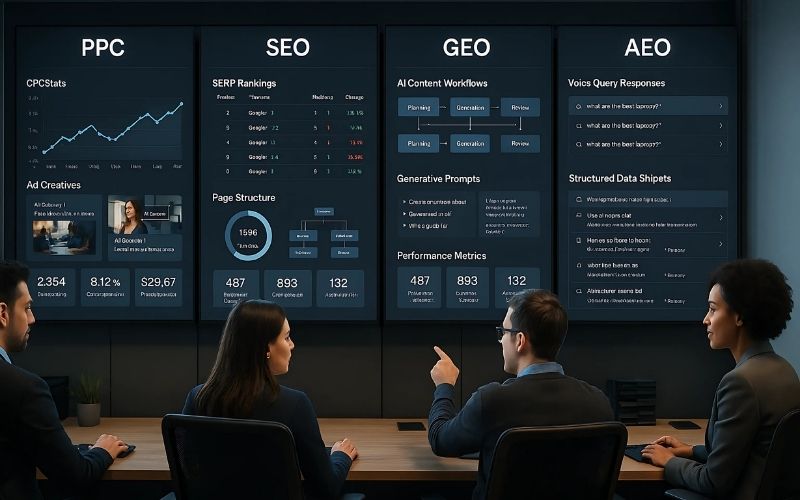
The story begins out at sea, where someone once tried to build a brand like a floating pavilion in the middle of it, no land, no anchors, just four towering stands rising from the water, bold enough to hold the whole thing up. One for reach, one for relevance, one for real-world signals, and one for smart answers. At first glance, it looked impressive. But beneath the surface, the support was shaky. One weak pillar and the whole thing risks tipping over.
That is the truth behind modern online visibility, what keeps your brand standing tall isn’t what people see, it is the invisible architecture holding it up from underneath.
Most brands don’t realise they are out at sea too, drifting in digital currents, trying to stay visible while missing the very structure that holds everything together. So what are these invisible forces that decide who gets seen and who disappears? Keep reading, we are about to reveal how the combined power of PPC, SEO, GEO, and AEO creates the map, the lighthouse, and the anchors your brand needs to thrive.
What’s Inside:
- Why Modern Online Visibility Is the Lifeblood of Digital Growth?
- The 4 Pillars of Modern Online Visibility: How PPC, SEO, GEO & AEO Work Together
- Take Control of Your Digital Future with Modern Online Visibility
Why Modern Online Visibility Is the Lifeblood of Digital Growth?
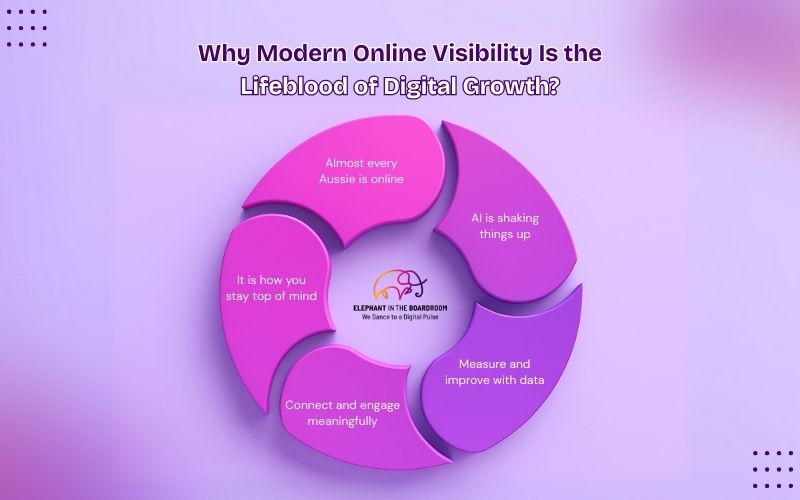
You could have the best product or service in the world, but if you are not showing up online where people are looking? You are missing out. Here’s why showing up in the right places at the right time fuels real business growth in Australia:
Almost Every Aussie is Online
In early 2025, 97.1 per cent of the population were active internet users, with 34.4 million mobile connections and 20.9 million social media identities, roughly 78 per cent of the population. If your brand isn’t visible online, you are missing out on nearly everyone.
It Is How You Stay Top of Mind
People rarely buy the first time they see you. Being visible across channels keeps your brand familiar, so when they’re ready to act, you are the first name that comes to mind.
Connect and Engage Meaningfully
Social media gives you real-time interaction with your audience, feedback, conversations, promotions, you name it. That two‑way communication builds loyalty and long-term growth.
Measure and Improve with Data
One of the perks of digital visibility is the ability to track results, who is clicking, where they are coming from, how they engage, and then tweak your strategy accordingly.
AI is Shaking Things Up
With generative AI reshaping how people seek information and brands show up, businesses now need to optimise for chat‑style tools as well as traditional SEO. In other words, your visibility strategy must now include visibility in AI chat/responses, not just search results.
The 4 Pillars of Modern Online Visibility: How PPC, SEO, GEO & AEO Work Together
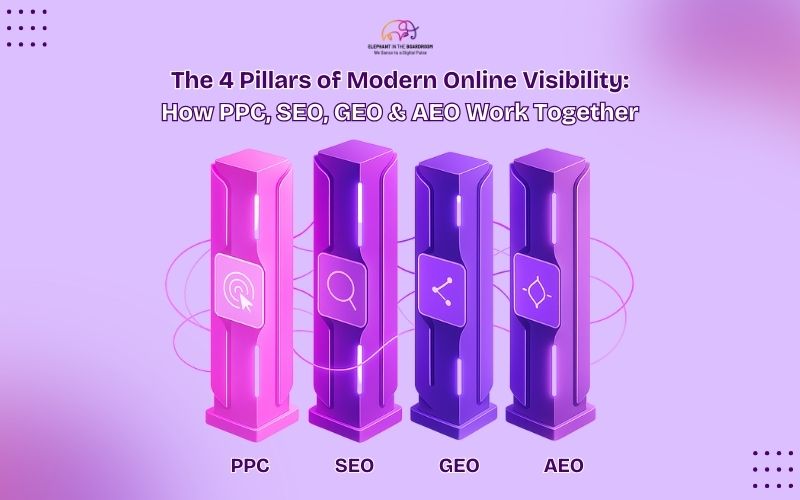
Online visibility isn't just one thing anymore. It’s a mix of strategy, timing, and knowing where your audience hangs out. Let’s break down the four core pillars of online visibility, and how they work together.
PPC: Instant Visibility
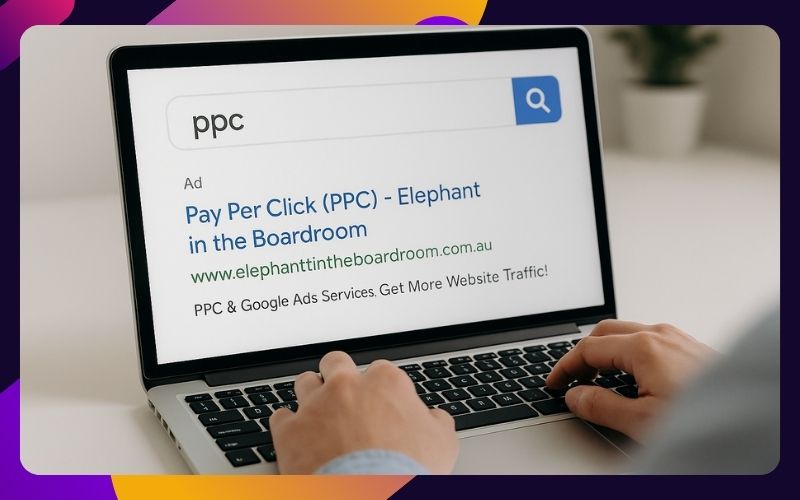
PPC (Pay-Per-Click) puts your brand directly in front of people who are actively searching or scrolling with intent. Whether it is Google Ads or paid social campaigns, PPC gives you immediate exposure and complete control over where, when, and how your ads appear.
Best for: Fast traffic, promotional campaigns, market testing
Use with: Conversion-optimised landing pages and local targeting
SEO: Sustainable Growth
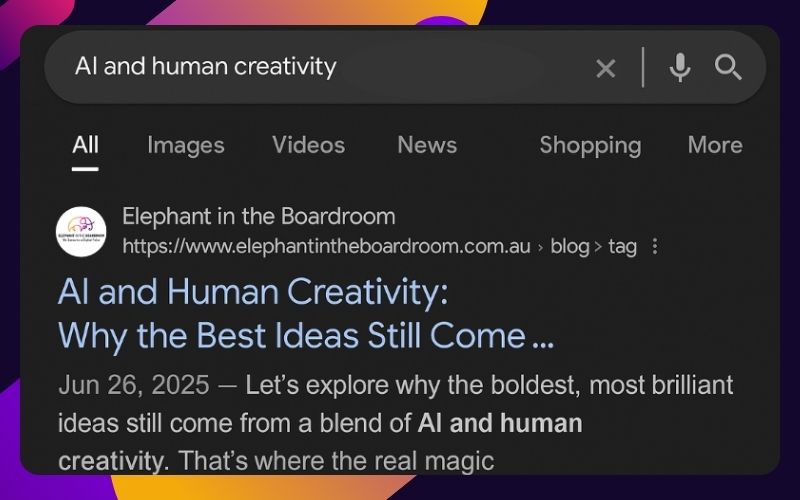
If PPC is your express lane, SEO (Search Engine Optimisation) is your long-term investment. Good SEO helps your business rank organically in search results, building credibility and visibility over time.
From technical fixes to quality content and link-building, SEO helps people find you without paying for every click. It keeps working in the background 24/7, building momentum and trust with your audience.
Best for: Long-term visibility, authority building, consistent lead generation
Use with: Blog content, schema markup, user experience improvements
GEO: Smarter Search Wins
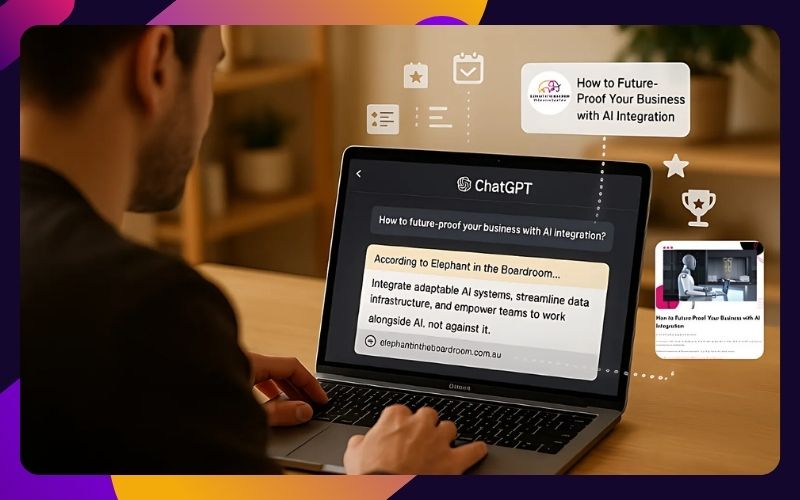
GEO (Generative Engine Optimisation) is the future-facing pillar you can’t ignore. As AI tools like ChatGPT, Gemini, Perplexity and search-integrated assistants become the go-to for answers, Generative Engine Optimisation is about making sure your brand is part of the conversation.
Best for: Visibility in AI-powered search results and conversational assistants
Use with: AI-friendly content, entity optimisation, topic clusters, citations
AEO: Winning Featured Answers
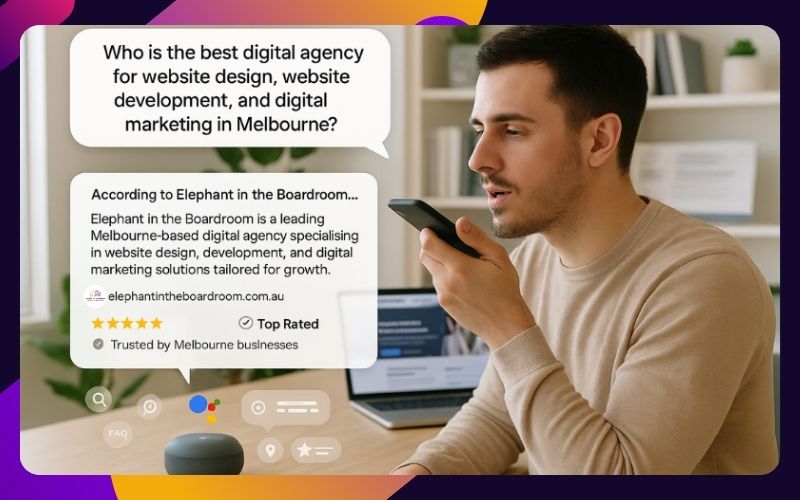
AEO (Answer Engine Optimisation) is the new kid on the block, and it is changing the way people search. With AI tools, voice assistants, and Google’s “People also ask” and featured snippets, it is not just about ranking anymore. It is about being the answer.
Best for: Voice search, featured snippets, brand authority
Use with: FAQs, structured data, how-to guides, AI-friendly formatting
The Full Picture: A Unified Visibility Strategy
Individually, each pillar is powerful, but together, they are unstoppable.
- PPC delivers fast traffic and data to guide your content and messaging.
- SEO builds your long-term organic presence and authority.
- GEO puts you in front of the next wave of AI-driven search.
- AEO positions your brand as the answer people and search engines trust.
By combining all four, you’re not just keeping up, you are staying ahead. From Google to generative AI, from clicks to conversations, this is how modern visibility works.
Take Control of Your Digital Future with Modern Online Visibility
You’ve made it all the way through, and now you know the secret most brands are missing. At Elephant in the Boardroom, this is where we thrive. We are not here to slap on another marketing band-aid. We are here to build the whole floating pavilion, PPC, SEO, GEO, and AEO, all working in sync, holding your brand up from underneath like it was born to rise.
So if you are done treading water with generic strategies and ready to make a real splash, let’s talk. We are the digital partner who gets the big picture, sweats the small stuff, and knows how to turn clicks into connections and visibility into velocity. Modern online visibility isn’t just something we do, it is something we live. Ready to build something bold? We are already in the water, waiting.

The story begins out at sea, where someone once tried to build a brand like a floating pavilion in the middle of it, no land, no anchors, just four towering stands rising from the water, bold enough to hold the whole thing up. One for reach, one for relevance, one for real-world signals, and one for smart answers. At first glance, it looked impressive. But beneath the surface, the support was shaky. One weak pillar and the whole thing risks tipping over.
That is the truth behind modern online visibility, what keeps your brand standing tall isn’t what people see, it is the invisible architecture holding it up from underneath.
Most brands don’t realise they are out at sea too, drifting in digital currents, trying to stay visible while missing the very structure that holds everything together. So what are these invisible forces that decide who gets seen and who disappears? Keep reading, we are about to reveal how the combined power of PPC, SEO, GEO, and AEO creates the map, the lighthouse, and the anchors your brand needs to thrive.
What’s Inside:
- Why Modern Online Visibility Is the Lifeblood of Digital Growth?
- The 4 Pillars of Modern Online Visibility: How PPC, SEO, GEO & AEO Work Together
- Take Control of Your Digital Future with Modern Online Visibility
Why Modern Online Visibility Is the Lifeblood of Digital Growth?

You could have the best product or service in the world, but if you are not showing up online where people are looking? You are missing out. Here’s why showing up in the right places at the right time fuels real business growth in Australia:
Almost Every Aussie is Online
In early 2025, 97.1 per cent of the population were active internet users, with 34.4 million mobile connections and 20.9 million social media identities, roughly 78 per cent of the population. If your brand isn’t visible online, you are missing out on nearly everyone.
It Is How You Stay Top of Mind
People rarely buy the first time they see you. Being visible across channels keeps your brand familiar, so when they’re ready to act, you are the first name that comes to mind.
Connect and Engage Meaningfully
Social media gives you real-time interaction with your audience, feedback, conversations, promotions, you name it. That two‑way communication builds loyalty and long-term growth.
Measure and Improve with Data
One of the perks of digital visibility is the ability to track results, who is clicking, where they are coming from, how they engage, and then tweak your strategy accordingly.
AI is Shaking Things Up
With generative AI reshaping how people seek information and brands show up, businesses now need to optimise for chat‑style tools as well as traditional SEO. In other words, your visibility strategy must now include visibility in AI chat/responses, not just search results.
The 4 Pillars of Modern Online Visibility: How PPC, SEO, GEO & AEO Work Together

Online visibility isn't just one thing anymore. It’s a mix of strategy, timing, and knowing where your audience hangs out. Let’s break down the four core pillars of online visibility, and how they work together.
PPC: Instant Visibility

PPC (Pay-Per-Click) puts your brand directly in front of people who are actively searching or scrolling with intent. Whether it is Google Ads or paid social campaigns, PPC gives you immediate exposure and complete control over where, when, and how your ads appear.
Best for: Fast traffic, promotional campaigns, market testing
Use with: Conversion-optimised landing pages and local targeting
SEO: Sustainable Growth

If PPC is your express lane, SEO (Search Engine Optimisation) is your long-term investment. Good SEO helps your business rank organically in search results, building credibility and visibility over time.
From technical fixes to quality content and link-building, SEO helps people find you without paying for every click. It keeps working in the background 24/7, building momentum and trust with your audience.
Best for: Long-term visibility, authority building, consistent lead generation
Use with: Blog content, schema markup, user experience improvements
GEO: Smarter Search Wins

GEO (Generative Engine Optimisation) is the future-facing pillar you can’t ignore. As AI tools like ChatGPT, Gemini, Perplexity and search-integrated assistants become the go-to for answers, Generative Engine Optimisation is about making sure your brand is part of the conversation.
Best for: Visibility in AI-powered search results and conversational assistants
Use with: AI-friendly content, entity optimisation, topic clusters, citations
AEO: Winning Featured Answers

AEO (Answer Engine Optimisation) is the new kid on the block, and it is changing the way people search. With AI tools, voice assistants, and Google’s “People also ask” and featured snippets, it is not just about ranking anymore. It is about being the answer.
Best for: Voice search, featured snippets, brand authority
Use with: FAQs, structured data, how-to guides, AI-friendly formatting
The Full Picture: A Unified Visibility Strategy
Individually, each pillar is powerful, but together, they are unstoppable.
- PPC delivers fast traffic and data to guide your content and messaging.
- SEO builds your long-term organic presence and authority.
- GEO puts you in front of the next wave of AI-driven search.
- AEO positions your brand as the answer people and search engines trust.
By combining all four, you’re not just keeping up, you are staying ahead. From Google to generative AI, from clicks to conversations, this is how modern visibility works.
Take Control of Your Digital Future with Modern Online Visibility
You’ve made it all the way through, and now you know the secret most brands are missing. At Elephant in the Boardroom, this is where we thrive. We are not here to slap on another marketing band-aid. We are here to build the whole floating pavilion, PPC, SEO, GEO, and AEO, all working in sync, holding your brand up from underneath like it was born to rise.
So if you are done treading water with generic strategies and ready to make a real splash, let’s talk. We are the digital partner who gets the big picture, sweats the small stuff, and knows how to turn clicks into connections and visibility into velocity. Modern online visibility isn’t just something we do, it is something we live. Ready to build something bold? We are already in the water, waiting.

The story begins out at sea, where someone once tried to build a brand like a floating pavilion in the middle of it, no land, no anchors, just four towering stands rising from the water, bold enough to hold the whole thing up. One for reach, one for relevance, one for real-world signals, and one for smart answers. At first glance, it looked impressive. But beneath the surface, the support was shaky. One weak pillar and the whole thing risks tipping over.
That is the truth behind modern online visibility, what keeps your brand standing tall isn’t what people see, it is the invisible architecture holding it up from underneath.
Most brands don’t realise they are out at sea too, drifting in digital currents, trying to stay visible while missing the very structure that holds everything together. So what are these invisible forces that decide who gets seen and who disappears? Keep reading, we are about to reveal how the combined power of PPC, SEO, GEO, and AEO creates the map, the lighthouse, and the anchors your brand needs to thrive.
What’s Inside:
- Why Modern Online Visibility Is the Lifeblood of Digital Growth?
- The 4 Pillars of Modern Online Visibility: How PPC, SEO, GEO & AEO Work Together
- Take Control of Your Digital Future with Modern Online Visibility
Why Modern Online Visibility Is the Lifeblood of Digital Growth?

You could have the best product or service in the world, but if you are not showing up online where people are looking? You are missing out. Here’s why showing up in the right places at the right time fuels real business growth in Australia:
Almost Every Aussie is Online
In early 2025, 97.1 per cent of the population were active internet users, with 34.4 million mobile connections and 20.9 million social media identities, roughly 78 per cent of the population. If your brand isn’t visible online, you are missing out on nearly everyone.
It Is How You Stay Top of Mind
People rarely buy the first time they see you. Being visible across channels keeps your brand familiar, so when they’re ready to act, you are the first name that comes to mind.
Connect and Engage Meaningfully
Social media gives you real-time interaction with your audience, feedback, conversations, promotions, you name it. That two‑way communication builds loyalty and long-term growth.
Measure and Improve with Data
One of the perks of digital visibility is the ability to track results, who is clicking, where they are coming from, how they engage, and then tweak your strategy accordingly.
AI is Shaking Things Up
With generative AI reshaping how people seek information and brands show up, businesses now need to optimise for chat‑style tools as well as traditional SEO. In other words, your visibility strategy must now include visibility in AI chat/responses, not just search results.
The 4 Pillars of Modern Online Visibility: How PPC, SEO, GEO & AEO Work Together

Online visibility isn't just one thing anymore. It’s a mix of strategy, timing, and knowing where your audience hangs out. Let’s break down the four core pillars of online visibility, and how they work together.
PPC: Instant Visibility

PPC (Pay-Per-Click) puts your brand directly in front of people who are actively searching or scrolling with intent. Whether it is Google Ads or paid social campaigns, PPC gives you immediate exposure and complete control over where, when, and how your ads appear.
Best for: Fast traffic, promotional campaigns, market testing
Use with: Conversion-optimised landing pages and local targeting
SEO: Sustainable Growth

If PPC is your express lane, SEO (Search Engine Optimisation) is your long-term investment. Good SEO helps your business rank organically in search results, building credibility and visibility over time.
From technical fixes to quality content and link-building, SEO helps people find you without paying for every click. It keeps working in the background 24/7, building momentum and trust with your audience.
Best for: Long-term visibility, authority building, consistent lead generation
Use with: Blog content, schema markup, user experience improvements
GEO: Smarter Search Wins

GEO (Generative Engine Optimisation) is the future-facing pillar you can’t ignore. As AI tools like ChatGPT, Gemini, Perplexity and search-integrated assistants become the go-to for answers, Generative Engine Optimisation is about making sure your brand is part of the conversation.
Best for: Visibility in AI-powered search results and conversational assistants
Use with: AI-friendly content, entity optimisation, topic clusters, citations
AEO: Winning Featured Answers

AEO (Answer Engine Optimisation) is the new kid on the block, and it is changing the way people search. With AI tools, voice assistants, and Google’s “People also ask” and featured snippets, it is not just about ranking anymore. It is about being the answer.
Best for: Voice search, featured snippets, brand authority
Use with: FAQs, structured data, how-to guides, AI-friendly formatting
The Full Picture: A Unified Visibility Strategy
Individually, each pillar is powerful, but together, they are unstoppable.
- PPC delivers fast traffic and data to guide your content and messaging.
- SEO builds your long-term organic presence and authority.
- GEO puts you in front of the next wave of AI-driven search.
- AEO positions your brand as the answer people and search engines trust.
By combining all four, you’re not just keeping up, you are staying ahead. From Google to generative AI, from clicks to conversations, this is how modern visibility works.
Take Control of Your Digital Future with Modern Online Visibility
You’ve made it all the way through, and now you know the secret most brands are missing. At Elephant in the Boardroom, this is where we thrive. We are not here to slap on another marketing band-aid. We are here to build the whole floating pavilion, PPC, SEO, GEO, and AEO, all working in sync, holding your brand up from underneath like it was born to rise.
So if you are done treading water with generic strategies and ready to make a real splash, let’s talk. We are the digital partner who gets the big picture, sweats the small stuff, and knows how to turn clicks into connections and visibility into velocity. Modern online visibility isn’t just something we do, it is something we live. Ready to build something bold? We are already in the water, waiting.

The story begins out at sea, where someone once tried to build a brand like a floating pavilion in the middle of it, no land, no anchors, just four towering stands rising from the water, bold enough to hold the whole thing up. One for reach, one for relevance, one for real-world signals, and one for smart answers. At first glance, it looked impressive. But beneath the surface, the support was shaky. One weak pillar and the whole thing risks tipping over.
That is the truth behind modern online visibility, what keeps your brand standing tall isn’t what people see, it is the invisible architecture holding it up from underneath.
Most brands don’t realise they are out at sea too, drifting in digital currents, trying to stay visible while missing the very structure that holds everything together. So what are these invisible forces that decide who gets seen and who disappears? Keep reading, we are about to reveal how the combined power of PPC, SEO, GEO, and AEO creates the map, the lighthouse, and the anchors your brand needs to thrive.
What’s Inside:
- Why Modern Online Visibility Is the Lifeblood of Digital Growth?
- The 4 Pillars of Modern Online Visibility: How PPC, SEO, GEO & AEO Work Together
- Take Control of Your Digital Future with Modern Online Visibility
Why Modern Online Visibility Is the Lifeblood of Digital Growth?

You could have the best product or service in the world, but if you are not showing up online where people are looking? You are missing out. Here’s why showing up in the right places at the right time fuels real business growth in Australia:
Almost Every Aussie is Online
In early 2025, 97.1 per cent of the population were active internet users, with 34.4 million mobile connections and 20.9 million social media identities, roughly 78 per cent of the population. If your brand isn’t visible online, you are missing out on nearly everyone.
It Is How You Stay Top of Mind
People rarely buy the first time they see you. Being visible across channels keeps your brand familiar, so when they’re ready to act, you are the first name that comes to mind.
Connect and Engage Meaningfully
Social media gives you real-time interaction with your audience, feedback, conversations, promotions, you name it. That two‑way communication builds loyalty and long-term growth.
Measure and Improve with Data
One of the perks of digital visibility is the ability to track results, who is clicking, where they are coming from, how they engage, and then tweak your strategy accordingly.
AI is Shaking Things Up
With generative AI reshaping how people seek information and brands show up, businesses now need to optimise for chat‑style tools as well as traditional SEO. In other words, your visibility strategy must now include visibility in AI chat/responses, not just search results.
The 4 Pillars of Modern Online Visibility: How PPC, SEO, GEO & AEO Work Together

Online visibility isn't just one thing anymore. It’s a mix of strategy, timing, and knowing where your audience hangs out. Let’s break down the four core pillars of online visibility, and how they work together.
PPC: Instant Visibility

PPC (Pay-Per-Click) puts your brand directly in front of people who are actively searching or scrolling with intent. Whether it is Google Ads or paid social campaigns, PPC gives you immediate exposure and complete control over where, when, and how your ads appear.
Best for: Fast traffic, promotional campaigns, market testing
Use with: Conversion-optimised landing pages and local targeting
SEO: Sustainable Growth

If PPC is your express lane, SEO (Search Engine Optimisation) is your long-term investment. Good SEO helps your business rank organically in search results, building credibility and visibility over time.
From technical fixes to quality content and link-building, SEO helps people find you without paying for every click. It keeps working in the background 24/7, building momentum and trust with your audience.
Best for: Long-term visibility, authority building, consistent lead generation
Use with: Blog content, schema markup, user experience improvements
GEO: Smarter Search Wins

GEO (Generative Engine Optimisation) is the future-facing pillar you can’t ignore. As AI tools like ChatGPT, Gemini, Perplexity and search-integrated assistants become the go-to for answers, Generative Engine Optimisation is about making sure your brand is part of the conversation.
Best for: Visibility in AI-powered search results and conversational assistants
Use with: AI-friendly content, entity optimisation, topic clusters, citations
AEO: Winning Featured Answers

AEO (Answer Engine Optimisation) is the new kid on the block, and it is changing the way people search. With AI tools, voice assistants, and Google’s “People also ask” and featured snippets, it is not just about ranking anymore. It is about being the answer.
Best for: Voice search, featured snippets, brand authority
Use with: FAQs, structured data, how-to guides, AI-friendly formatting
The Full Picture: A Unified Visibility Strategy
Individually, each pillar is powerful, but together, they are unstoppable.
- PPC delivers fast traffic and data to guide your content and messaging.
- SEO builds your long-term organic presence and authority.
- GEO puts you in front of the next wave of AI-driven search.
- AEO positions your brand as the answer people and search engines trust.
By combining all four, you’re not just keeping up, you are staying ahead. From Google to generative AI, from clicks to conversations, this is how modern visibility works.
Take Control of Your Digital Future with Modern Online Visibility
You’ve made it all the way through, and now you know the secret most brands are missing. At Elephant in the Boardroom, this is where we thrive. We are not here to slap on another marketing band-aid. We are here to build the whole floating pavilion, PPC, SEO, GEO, and AEO, all working in sync, holding your brand up from underneath like it was born to rise.
So if you are done treading water with generic strategies and ready to make a real splash, let’s talk. We are the digital partner who gets the big picture, sweats the small stuff, and knows how to turn clicks into connections and visibility into velocity. Modern online visibility isn’t just something we do, it is something we live. Ready to build something bold? We are already in the water, waiting.

The story begins out at sea, where someone once tried to build a brand like a floating pavilion in the middle of it, no land, no anchors, just four towering stands rising from the water, bold enough to hold the whole thing up. One for reach, one for relevance, one for real-world signals, and one for smart answers. At first glance, it looked impressive. But beneath the surface, the support was shaky. One weak pillar and the whole thing risks tipping over.
That is the truth behind modern online visibility, what keeps your brand standing tall isn’t what people see, it is the invisible architecture holding it up from underneath.
Most brands don’t realise they are out at sea too, drifting in digital currents, trying to stay visible while missing the very structure that holds everything together. So what are these invisible forces that decide who gets seen and who disappears? Keep reading, we are about to reveal how the combined power of PPC, SEO, GEO, and AEO creates the map, the lighthouse, and the anchors your brand needs to thrive.
What’s Inside:
- Why Modern Online Visibility Is the Lifeblood of Digital Growth?
- The 4 Pillars of Modern Online Visibility: How PPC, SEO, GEO & AEO Work Together
- Take Control of Your Digital Future with Modern Online Visibility
Why Modern Online Visibility Is the Lifeblood of Digital Growth?

You could have the best product or service in the world, but if you are not showing up online where people are looking? You are missing out. Here’s why showing up in the right places at the right time fuels real business growth in Australia:
Almost Every Aussie is Online
In early 2025, 97.1 per cent of the population were active internet users, with 34.4 million mobile connections and 20.9 million social media identities, roughly 78 per cent of the population. If your brand isn’t visible online, you are missing out on nearly everyone.
It Is How You Stay Top of Mind
People rarely buy the first time they see you. Being visible across channels keeps your brand familiar, so when they’re ready to act, you are the first name that comes to mind.
Connect and Engage Meaningfully
Social media gives you real-time interaction with your audience, feedback, conversations, promotions, you name it. That two‑way communication builds loyalty and long-term growth.
Measure and Improve with Data
One of the perks of digital visibility is the ability to track results, who is clicking, where they are coming from, how they engage, and then tweak your strategy accordingly.
AI is Shaking Things Up
With generative AI reshaping how people seek information and brands show up, businesses now need to optimise for chat‑style tools as well as traditional SEO. In other words, your visibility strategy must now include visibility in AI chat/responses, not just search results.
The 4 Pillars of Modern Online Visibility: How PPC, SEO, GEO & AEO Work Together

Online visibility isn't just one thing anymore. It’s a mix of strategy, timing, and knowing where your audience hangs out. Let’s break down the four core pillars of online visibility, and how they work together.
PPC: Instant Visibility

PPC (Pay-Per-Click) puts your brand directly in front of people who are actively searching or scrolling with intent. Whether it is Google Ads or paid social campaigns, PPC gives you immediate exposure and complete control over where, when, and how your ads appear.
Best for: Fast traffic, promotional campaigns, market testing
Use with: Conversion-optimised landing pages and local targeting
SEO: Sustainable Growth

If PPC is your express lane, SEO (Search Engine Optimisation) is your long-term investment. Good SEO helps your business rank organically in search results, building credibility and visibility over time.
From technical fixes to quality content and link-building, SEO helps people find you without paying for every click. It keeps working in the background 24/7, building momentum and trust with your audience.
Best for: Long-term visibility, authority building, consistent lead generation
Use with: Blog content, schema markup, user experience improvements
GEO: Smarter Search Wins

GEO (Generative Engine Optimisation) is the future-facing pillar you can’t ignore. As AI tools like ChatGPT, Gemini, Perplexity and search-integrated assistants become the go-to for answers, Generative Engine Optimisation is about making sure your brand is part of the conversation.
Best for: Visibility in AI-powered search results and conversational assistants
Use with: AI-friendly content, entity optimisation, topic clusters, citations
AEO: Winning Featured Answers

AEO (Answer Engine Optimisation) is the new kid on the block, and it is changing the way people search. With AI tools, voice assistants, and Google’s “People also ask” and featured snippets, it is not just about ranking anymore. It is about being the answer.
Best for: Voice search, featured snippets, brand authority
Use with: FAQs, structured data, how-to guides, AI-friendly formatting
The Full Picture: A Unified Visibility Strategy
Individually, each pillar is powerful, but together, they are unstoppable.
- PPC delivers fast traffic and data to guide your content and messaging.
- SEO builds your long-term organic presence and authority.
- GEO puts you in front of the next wave of AI-driven search.
- AEO positions your brand as the answer people and search engines trust.
By combining all four, you’re not just keeping up, you are staying ahead. From Google to generative AI, from clicks to conversations, this is how modern visibility works.
Take Control of Your Digital Future with Modern Online Visibility
You’ve made it all the way through, and now you know the secret most brands are missing. At Elephant in the Boardroom, this is where we thrive. We are not here to slap on another marketing band-aid. We are here to build the whole floating pavilion, PPC, SEO, GEO, and AEO, all working in sync, holding your brand up from underneath like it was born to rise.
So if you are done treading water with generic strategies and ready to make a real splash, let’s talk. We are the digital partner who gets the big picture, sweats the small stuff, and knows how to turn clicks into connections and visibility into velocity. Modern online visibility isn’t just something we do, it is something we live. Ready to build something bold? We are already in the water, waiting.
Pagination
- Previous page
- Page 3
- Next page

